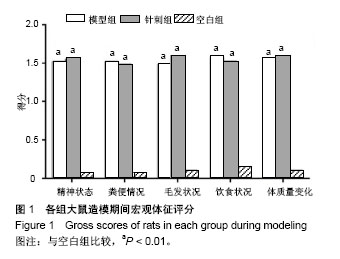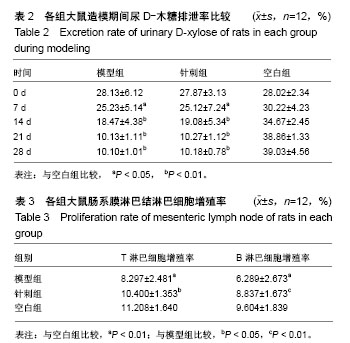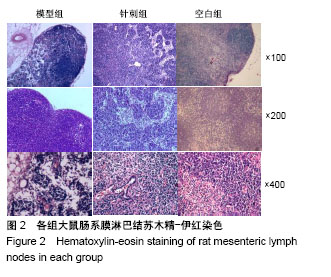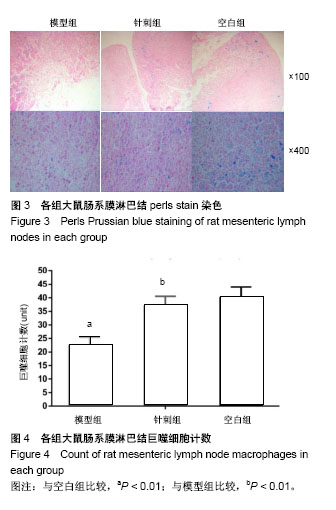中国组织工程研究 ›› 2018, Vol. 22 ›› Issue (36): 5846-5851.doi: 10.3969/j.issn.2095-4344.0698
• 组织构建实验造模 experimental modeling in tissue construction • 上一篇 下一篇
针刺脾气虚证模型大鼠“足三里”穴后肠系膜淋巴结免疫功能的变化
曾荣华,吴慧婷,周 露,欧阳厚淦,高书亮,汪建民,欧阳彦楚,崔田田
- (江西中医药大学,江西省南昌市 330004)
Changes of immune function of mesenteric lymph nodes in rats with spleen deficiency syndrome after acupuncture at Zusanli
Zeng Ronghua, Wu Huiting, Zhou Lu, Ouyang Hougan, Gao Shuliang, Wang Jianmin, Ouyang Yanchu, Cui Tiantian
- (Jiangxi University of Traditional Chinese Medicine, Nanchang 330004, Jiangxi Province, China)
摘要:
文章快速阅读:
.jpg) 文题释义:
黏膜免疫系统:是机体整个免疫网络的重要组成部分,又是具有独特结构和功能的独立免疫体系,它在抵抗感染方面起着极其重要的作用,黏膜表面与外界抗原直接接触,是机体抵抗感染的第一道防线,它可以将外来病原微生物或其他外来抗原在侵入机体组织之前被消灭,不至于对机体组织造成损伤。
巨噬细胞:来源于骨髓,在骨髓分化为前单核细胞进入血液,分化为成熟的单核细胞随后迁徙居留到不同组织中分化为具有不同功能的异质性吞噬细胞亚群。吞噬细胞具有两种基本功能,吞噬作用和获得性免疫。巨噬细胞在抵抗病原微生物入侵的免疫应答中主要发挥吞噬病原微生物的作用,同时巨噬细胞能够分泌释放多种细胞因子和强力的趋化因子,可以对抗原进行识别和递呈。
文题释义:
黏膜免疫系统:是机体整个免疫网络的重要组成部分,又是具有独特结构和功能的独立免疫体系,它在抵抗感染方面起着极其重要的作用,黏膜表面与外界抗原直接接触,是机体抵抗感染的第一道防线,它可以将外来病原微生物或其他外来抗原在侵入机体组织之前被消灭,不至于对机体组织造成损伤。
巨噬细胞:来源于骨髓,在骨髓分化为前单核细胞进入血液,分化为成熟的单核细胞随后迁徙居留到不同组织中分化为具有不同功能的异质性吞噬细胞亚群。吞噬细胞具有两种基本功能,吞噬作用和获得性免疫。巨噬细胞在抵抗病原微生物入侵的免疫应答中主要发挥吞噬病原微生物的作用,同时巨噬细胞能够分泌释放多种细胞因子和强力的趋化因子,可以对抗原进行识别和递呈。
.jpg) 文题释义:
黏膜免疫系统:是机体整个免疫网络的重要组成部分,又是具有独特结构和功能的独立免疫体系,它在抵抗感染方面起着极其重要的作用,黏膜表面与外界抗原直接接触,是机体抵抗感染的第一道防线,它可以将外来病原微生物或其他外来抗原在侵入机体组织之前被消灭,不至于对机体组织造成损伤。
巨噬细胞:来源于骨髓,在骨髓分化为前单核细胞进入血液,分化为成熟的单核细胞随后迁徙居留到不同组织中分化为具有不同功能的异质性吞噬细胞亚群。吞噬细胞具有两种基本功能,吞噬作用和获得性免疫。巨噬细胞在抵抗病原微生物入侵的免疫应答中主要发挥吞噬病原微生物的作用,同时巨噬细胞能够分泌释放多种细胞因子和强力的趋化因子,可以对抗原进行识别和递呈。
文题释义:
黏膜免疫系统:是机体整个免疫网络的重要组成部分,又是具有独特结构和功能的独立免疫体系,它在抵抗感染方面起着极其重要的作用,黏膜表面与外界抗原直接接触,是机体抵抗感染的第一道防线,它可以将外来病原微生物或其他外来抗原在侵入机体组织之前被消灭,不至于对机体组织造成损伤。
巨噬细胞:来源于骨髓,在骨髓分化为前单核细胞进入血液,分化为成熟的单核细胞随后迁徙居留到不同组织中分化为具有不同功能的异质性吞噬细胞亚群。吞噬细胞具有两种基本功能,吞噬作用和获得性免疫。巨噬细胞在抵抗病原微生物入侵的免疫应答中主要发挥吞噬病原微生物的作用,同时巨噬细胞能够分泌释放多种细胞因子和强力的趋化因子,可以对抗原进行识别和递呈。摘要
背景:肠道及相关淋巴组织是构成肠道免疫的重要组成部分,在脾虚免疫失衡中肠道免疫起到了重要的调节作用。
目的:观察针刺对脾虚症大鼠肠系膜淋巴结组织结构的变化、淋巴细胞增殖活化及巨噬细胞吞噬功能的影响,探讨脾虚与肠道黏膜免疫之间相关性及针刺治疗脾虚证的作用机制。
方法:选用36只SPF级雌性SD大鼠(购于安徽医科大学实验动物中心)随机分为3组,模型组及针刺组通过劳倦伤脾加饮食失节多因素复合法建立脾虚大鼠模型,通过脾虚模型体征评分及尿D-木糖排泄率检测证实造模成功后,针刺组大鼠针刺双侧“足三里”穴(1次/d,连续14 d),模型组自然恢复,空白组不予干预。治疗结束后摘取小肠肠系膜淋巴结,采用MTS法测定淋巴细胞增殖分化能力,苏木精-伊红染色法观察肠系膜淋巴结组织形态学改变,Perls stain(普鲁士蓝)染色法检测肠系膜淋巴结巨噬细胞数量。
结果与结论:①肠系膜淋巴结组织结构改变:空白组结构正常;模型组淋巴结网架结构遭到破坏,淋巴小结等结构不完整,淋巴结副皮质区弥漫性扩大变宽,淋巴结功能亢进;针刺组淋巴结小梁构成的实质网架结构基本趋于完整,淋巴小结等结构基本恢复;②肠系膜淋巴结淋巴细胞增殖功能:T淋巴细胞及B淋巴细胞的增殖转化呈相同的趋势,但T淋巴细胞增殖率要高于B淋巴细胞(P < 0.01);模型组的T、B淋巴细胞增殖率均低于空白组(P < 0.01);针刺组T淋巴细胞增殖率高于模型组(P < 0.01),与空白组比较差异无显著性意义(P > 0.05);针刺组B淋巴细胞增殖率低于空白组(P < 0.01),与模型组比较差异无显著性意义(P > 0.05);③巨噬细胞计数:针刺组的淋巴窦巨噬细胞分部密度高于模型组,低于空白组(P < 0.01)。提示:针刺“足三里”穴能激活脾虚证大鼠肠系膜淋巴结免疫应答,增强其淋巴细胞的增殖分化及巨噬细胞的吞噬活化能力(其中对T淋巴细胞增殖分化影响最明显),进而提高其肠道免疫功能,改善脾虚证大鼠脾虚症状,调整肠道消化功能紊乱状态。
中国组织工程研究杂志出版内容重点:组织构建;骨细胞;软骨细胞;细胞培养;成纤维细胞;血管内皮细胞;骨质疏松;组织工程
ORCID: 0000-0001-5263-4564(曾荣华)
中图分类号:




.jpg) 文题释义:
黏膜免疫系统:是机体整个免疫网络的重要组成部分,又是具有独特结构和功能的独立免疫体系,它在抵抗感染方面起着极其重要的作用,黏膜表面与外界抗原直接接触,是机体抵抗感染的第一道防线,它可以将外来病原微生物或其他外来抗原在侵入机体组织之前被消灭,不至于对机体组织造成损伤。
巨噬细胞:来源于骨髓,在骨髓分化为前单核细胞进入血液,分化为成熟的单核细胞随后迁徙居留到不同组织中分化为具有不同功能的异质性吞噬细胞亚群。吞噬细胞具有两种基本功能,吞噬作用和获得性免疫。巨噬细胞在抵抗病原微生物入侵的免疫应答中主要发挥吞噬病原微生物的作用,同时巨噬细胞能够分泌释放多种细胞因子和强力的趋化因子,可以对抗原进行识别和递呈。
文题释义:
黏膜免疫系统:是机体整个免疫网络的重要组成部分,又是具有独特结构和功能的独立免疫体系,它在抵抗感染方面起着极其重要的作用,黏膜表面与外界抗原直接接触,是机体抵抗感染的第一道防线,它可以将外来病原微生物或其他外来抗原在侵入机体组织之前被消灭,不至于对机体组织造成损伤。
巨噬细胞:来源于骨髓,在骨髓分化为前单核细胞进入血液,分化为成熟的单核细胞随后迁徙居留到不同组织中分化为具有不同功能的异质性吞噬细胞亚群。吞噬细胞具有两种基本功能,吞噬作用和获得性免疫。巨噬细胞在抵抗病原微生物入侵的免疫应答中主要发挥吞噬病原微生物的作用,同时巨噬细胞能够分泌释放多种细胞因子和强力的趋化因子,可以对抗原进行识别和递呈。